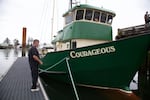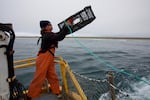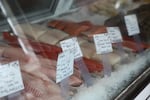John Hankins owns the boat "Courageous," which he sails out of Warrenton on the northern Oregon coast. He had a smile after returning from 25 days fishing for albacore.
"I'm full," he said. "Both tanks!"
The National Oceanic and Atmospheric Administration didn't assign a fisheries observer to his boat this trip. But he said, it happens fairly regularly.
“They’re usually not a problem for us. They’re measuring fish, they’re getting stats on the fish,” Hankins said.

John Hankins captains his fishing vessel "Courageous." He thinks having cameras on board instead of fisheries observes might stop some cheating, especially in the crabbing season.
Kristian Foden-Vencil / OPB
Fisheries observers are biologists tasked with monitoring commercial fisheries to collect data for conservation and stock management. They also make sure boats are in compliance with certain rules, such as having required safety equipment on board.
“We had one on the boat one time that was a real pain, because they didn’t like us talking negatively about whales," Hankins said. "And he got all bent out of shape for it. Other than that, we never have a problem with the observers."
But, he said, most of the time, the observer is just another person on board, with a job to do.
"They stay out of the way. Usually they don’t do much on the boat. But occasionally you’ll get one that’ll want to help us come in and handle fish or sort fish, cook a meal for us, or clean up the galley," Hankins said. "They’re usually pretty decent people to be around.”

Fisheries observers Sean Sullivan and Virginia Taggert measure and record the size of fish.
NOAA / NOAA
Traditionally, the fisheries observer job — part marine stock steward, part boat safety police officer — is low-paying, done by idealistic young scientists. They have to learn quickly to do their observing without getting in the way of the commercial fishing crew.
“I was really romanticizing the fishing industry going into it," former observer Briita Pajunas recalled. "I thought it would be kind of like the Wild West. Gritty. Dirty. Maybe even the danger of it was enticing. I certainly went into it very naive.”
When she started, Pajunas was fresh off an undergraduate degree in environmental studies. Her job focused on collecting data — counting what species are caught and what's thrown back — in an effort to keep commercial fisheries healthy long-term.
Related: Scent Research Could Help More Salmon Find Their Way Home
The observers' numbers can be used to set fishing quotas, which can, in turn, dictate how much money fishing professionals make.
Pajunas said she worked well on most boats, but there were times she felt intimidated. She said she once found a boat's safety equipment wasn't certified, so she had to delay a trip. Pajunas was so uncomfortable she put the captain on the phone with her supervisor.
But Pajunas said she usually figured out how to work around problems — like when she found someone poaching salmon.
“In a big garbage bin thing I found, there was a coho or two in there. And we kind of said: ‘Oh, I saw that. That happened,’" she said. "I record it in my log-book, but to avoid confrontation, I don’t dump that salmon overboard.”
She said there was also the time her boat was using a long fishing lines with multiple hooks, and sea birds were diving into the water for the bait and getting snared.
“A rare short-tailed albatross did come up on a hook when I was on a long-liner my last year of fishing. … That particular boat was catching quite a few sea birds,” she said.
She said it was tense, but she didn’t talk to the crew. She just took the bird back to her supervisor.
“A year later U.S. Fish and Wildlife Service … did want to interview to me and talk about that particular bird, because it was protected and it did have the potential of really having repercussions for that particular, fixed gear, long-line fishery,” she said.

Cameras on boats will be able to check all kinds of fisheries, from ground nets to crabbing.
Kristian Foden-Vencil / OPB
Cameras might be able to document birds caught on long lines, or poached fish, just as Pajunas did as an observer.
Pajunas agrees that cameras may identify problems and cost captains less than an observer. But she’s worried they might also miss things.
“There’s only so much you can see from a bird’s eye view," she said. "Even if you have some amazing high-quality cameras, they’re going to get splattered with fish slime and blood.”
Related: 'There Aren't A Lot Of Other Options:’ Port Orford’s Season Of Crab And Crisis
Pajunas said cameras also can’t thoroughly examine a fish to determine its age. And that’s important because older, larger fish procreate better and keep populations healthier.
Melissa Hooper, the monitoring branch chief for NOAA’s West Coast Region, thinks cameras will make fish data collection more efficient and probably cheaper. And while she agrees there are aspects of an observer's job that a camera can’t do, such as determining a fish’s age, she said some of that can be done onshore.
“So they bring them to the dock, where the species can be verified in person, at the dock,” Hooper said.
Fishing captain John Hankins worries cameras will be expensive. But he also thinks they have a benefit for fishing captains like him: They might catch cheaters, especially in the crab fishery.
“So when somebody else runs our crab gear. They’re taking the crabs out of our traps and so they’re taking money out of our pocket,” he explained.
Each vessel's crab buoys are painted in colors that are registered with the state — so cameras could tell if someone was pulling up somebody else’s crab pots.

Fisheries observers are biological scientists. Their job is to monitor commercial fisheries, collect data for conservation and stock management, and make sure all the safety equipment is up to compliance.
Kristian Foden-Vencil / OPB
NOAA’s new camera program was scheduled to start in January 2020. But it’s now been delayed until 2021 to give fishermen, the government and technology companies time to prepare.
The job also isn't likely to be eradicated all together: There's just likely to be a lot more cameras and a lot fewer boat-bound observers in the years to come.
